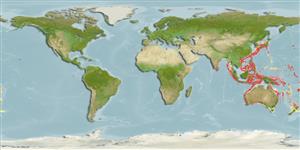Environment: milieu / climate zone / depth range / distribution range
นิเวศวิทยา
เกี่ยวกับทะเล,น้ำเค็ม สัตว์หน้าดินในเขตน้ำลึก; ระดับความลึก 140 - 600 m (Ref. 44036). Deep-water
Western Pacific: southern Japan. More recent works report of its occurrence in Taiwan (Ref. 5193), Malaysia (Ref. 5756) and the Chesterfield Islands (Ref. 11897).
ขนาด / น้ำหนัก / Age
Maturity: Lm ? range ? - ? cm
Max length : 95.0 cm SL เพศผู้/กระเทย; (Ref. 559); common length : 35.0 cm NG เพศผู้/กระเทย; (Ref. 27550)
เงี่ยงครีบหลัง (รวม): 0; ก้านครีบอ่อนที่หาง (รวม): 8-10; เงี่ยงครีบก้น 0. Longest ray of pelvic fin thin, long reaching to or near tip of pectoral fin. Lip of upper jaw thin. Upper jaw with a short band of villiform teeth; lower jaw, palatine, pre vomer and tongue toothless. Body purplish-brown, semi-transparent. Attain 95 cm SL.
Feeds on prawns (Ref. 27550).
Life cycle and mating behavior
วัยเจริญพันธุ์ | การสืบพันธุ์ | การวางไข่ | เซลสืบพันธ์ของเพศเมีย(ไข่) | ความดกของไข่ | ตัวอ่อน
Masuda, H., K. Amaoka, C. Araga, T. Uyeno and T. Yoshino, 1984. The fishes of the Japanese Archipelago. Vol. 1. Tokai University Press, Tokyo, Japan. 437 p. (text). (Ref. 559)
IUCN Red List Status (Ref. 130435)
Threat to humans
Harmless
Human uses
การประมง: ไม่มีผลประโยชน์
ข้อมูลเพิ่มเติม
ชื่อสามัญชื่อพ้องกลไกการเผาผลาญพลังงานผู้ล่าการศึกษาเกี่ยวกับผลกระทบของสารประกอบทางเคมีที่เป็นอันตรายต่อสิ่งมีชีวิต ประชากร และสิ่งแวดล้อมการสืบพันธุ์วัยเจริญพันธุ์การวางไข่การรวมกลุ่มวางไข่ความดกของไข่เซลสืบพันธ์ของเพศเมีย(ไข่)Egg development
อ้างอิงการเพาะเลี้ยงสัตว์น้ำประวัติการเพาะเลี้ยงสัตว์น้ำสายพันธุ์พันธุศาสตร์ElectrophoresesอัตราพันธุกรรมโรคการแปรรูปNutrientsMass conversion
เครื่องมือ
Special reports
Download XML
แหล่งที่มาจากอินเตอร์เน็ต
Estimates based on models
Preferred temperature (Ref.
123201): 8.1 - 18.9, mean 13.1 °C (based on 271 cells).
Phylogenetic diversity index (Ref.
82804): PD
50 = 0.5315 [Uniqueness, from 0.5 = low to 2.0 = high].
Bayesian length-weight: a=0.00389 (0.00180 - 0.00842), b=3.12 (2.94 - 3.30), in cm total length, based on all LWR estimates for this body shape (Ref.
93245).
ระดับชั้นอาหาร (Ref.
69278): 4.2 ±0.73 se; based on food items.
Fishing Vulnerability (Ref.
59153): High to very high vulnerability (70 of 100).
